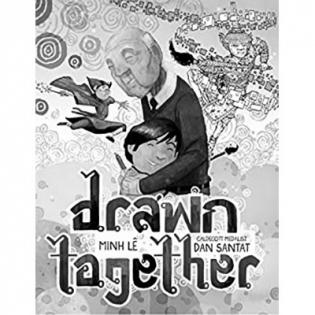Drawn Together Literature Guide
In this book, author Minh Le and illustrator Dan Santat weave together a beautiful story about finding connections and celebrating differences. The story has roots in the childhood experiences of the author and illustrator with their own grandparents. The author is Vietnamese American, and the illustrator is Thai American. The Asian grandfather and grandson in the story lack a common language and seek to bridge their communication divide through their shared love of art.
Literature Guide by Maureen Klein
Before Reading
Ask: The title of the book is Drawn Together. What are the different meanings of the word drawn together? As you read the book, look for ways both definitions of drawn together are used in the story.
Show: Looking at the front cover, what do you notice about the art and the relationship? Turn to the copyright page and read the dedication to the grandparents. Think about what you do with your grandparents and what they teach you.
Connect: This book includes words in Thai. Look at the copyright page to see the grandfather’s words in Thai translated to English. How might this be helpful as we read the book? Tell about a time you had to make meaning of words in another language.
During Reading
Ask: How do you think the boy is feeling when his mom leaves him with his grandfather? What do you think the grandfather feels? Talk about ways families support one another.
Show: Look at the picture of the meals the boy and his grandfather are eating. What do you notice about their food and their utensils? Why do you think they might be so different?
Connect: What are some ways they try to connect? What does the relationship between the boy and his grandfather make you think of? Have you ever felt like the boy or the grandfather?
After Reading
Ask: There are very few words in this book. Why do you think the author chose to let the illustrations tell the story? How is that choice related to the story?
Show: Look at the illustrations on the page that reads “All the things we could never say come pouring out…” What do you think the boy means by this? Talk about the symbolism and the details in the picture with the bridge.
Connect: The boy and the grandfather found a way to communicate even though they didn’t speak the same language. It isn’t always easy to talk with other people, even people in your own family. What are some things you can do or questions you can ask to help you communicate with other people?
Activities
- Draw a picture to communicate a message without words. Ask someone else to interpret the meaning of your message.
- Communication is improved when we notice and appreciate similarities and differences between ourselves and others. Noticing differences can open us to curiosity rather than close us to judgment. Create a Venn diagram describing the similarities and differences between the boy and his grandfather. Write a sentence about how their similarities and differences improved communication.
- Much of how we communicate is without words through our body language. Using only facial expressions and body language, play this “telephone game.”
- The art created by the boy and his grandfather followed their own artistic style. In this video, illustrator Dan Santant explains both forms of art and how their differences became a collaboration. Watch the video, then create your own drawing in either style.
- Generous listening is an act of philanthropy. Use resources from Learning to Give to participate in the Oral History Project.
- Drawn Together is based on the personal experiences of both the author and illustrator. They share similar experiences of what it is like to be from an immigrant family and some of the challenges they faced. Learn more about immigration and what it means to be an immigrant or refugee with this Learning to Give Toolkit.
- Make a list of different ways to communicate with people that draw you together. You may also make a list of communications that push people apart.
